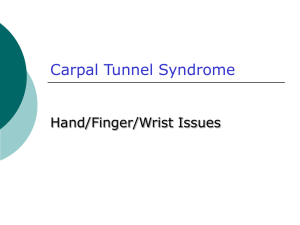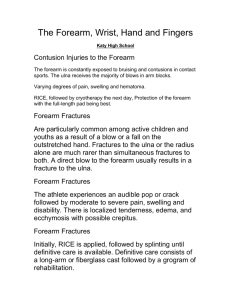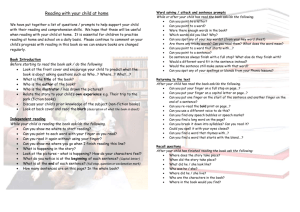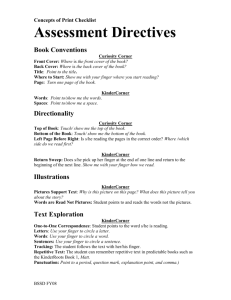TH-4.01 Common Hand and Wrist Injuries
advertisement
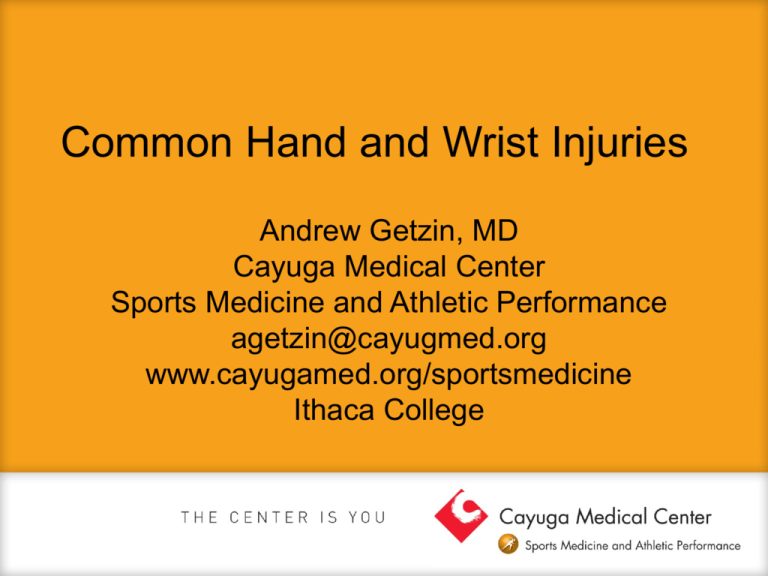
Common Hand and Wrist Injuries Andrew Getzin, MD Cayuga Medical Center Sports Medicine and Athletic Performance agetzin@cayugmed.org www.cayugamed.org/sportsmedicine Ithaca College How I Will Approach Each Problem • • • • What is it? Does it need any special imaging? How do I treat it? What are the indications to refer? Finger Injury Pearls • Treatment should restrict motion of the injured structures while allowing uninjured joints to remain mobile • Patients should be counseled that it is not unusual for an injured digit to remain swollen for some time and that permanent deformity is possible even after treatment Finger Pathology • Ligament/tendon injuries – Mallet Finger – Jersey Finger – Central slip extensor tendon injury (Boutonniere Deformity) – Collateral ligament injury – Volar plate injury – Skier’s thumb • Fractures, Dislocations – Distal Tuft Fractures/Crush injury – Phalange fractures – Metacarpal fractures • Boxer’s fracture – Dorsal PIP dislocations Finger Anatomy Finger Case 1 During infield practice a high school baseball player injured his dominant right pinky while covering his glove to field a grounder. The ball longitudinally hit his right 5th finger. He developed pain but kept playing. After practice, he noticed that he was unable to fully extend his distal phalange. He buddy taped it over the next few weeks but ultimately developed an extension lag that limits his ability to type but with no other functional limitations from the injury. Mallet Finger (Baseball Finger) • Injury to the extensor tendon at the DIP joint • Most common closed tendon injury of the finger • Mechanism: object striking finger, creating forced flexion • Tendon may be stretched, partially torn, or completely separated by a distal phalanx avulsion fracture Mallet Finger Presentation • Pain at dorsal DIP joint • Inability to actively extend the joint • Characteristic flexion deformity • On exam, very important to isolate the DIP joint to ensure extension from DIP and not the central slip • If can’t passively extend consider bony entrapment • All of these need x-rays Mallet Finger Treatment • • • • • • Splint DIP in neutral or slight hyperextension for 6 weeks Cochrane review- all splints same results Surgical wiring does not improve outcome Office visit every 2 weeks If not extension lag at 6 weeks, splint at night and for activity for 6 weeks. Conservative treatment effective up to 3 months delayed presentation Handoll. Interventions for treating mallet finger injuries. Cochrane Database 2004 Mallet Finger Referral • Bony avulsion >30% of joint space • Inability to achieve passive extension • Despite proper treatment permanent flexion of the fingertip is possible • No fracture reduction in the splint Finger Case 2 19 year old Ithaca College football player, defensive back was holding onto the running back by his jersey trying to tackle him but the back broke the tackle. The defensive player developed sudden distal 4th finger pain and was unable to fully flex the DIP joint. Jersey Finger Flexor Digitorum Profundus Tendon Injury (jersey finger) • Athlete’s finger catches another player’s clothing • Forced extension of the DIP joint during active flexion • 75% occur in the ring finger • Force can be concentrated at the middle or distal phalanx Jersey Finger Presentation • Pain and swelling at the volar aspect of DIP joint • Can often feel fullness proximally if tendon retracted • Need to isolate the DIP to properly test Jersey Finger Physical Exam Jersey Finger Treatment/ Referral All need to be referred for surgery immediately Central Slip Extensor Tendon Injury- Boutonnière deformity • PIP joint is forcibly flexed while actively extended • Volar dislocation of the PIP joint • Examine with PIP joint in 15-30 degrees of flexion, can’t active extend but can passively extend • Tenderness over dorsal aspect of the middle phalanx Central Slip Extensor Tendon Injury Treatment • A delay in proper treatment will cause boutonniere deformity • Deformity can develop over several weeks or occasionally acutely • Splint PIP in extension for 6 weeks • Can still play sports Central Slip Extensor Tendon Injury Referral • Avulsion fracture involving more than 30 percent of the joint • Inability to achieve full passive extension Collateral Ligament Injuries • • • • • Forced ulnar or radial deviation Can cause partial or complete tear PIP is usually involved Present with pain at the affected ligament Evaluate with involved joint at 30 degrees of flexion and MCP at 90 degrees of flexion Collateral Ligament InjuriesTreatment • If joint stable and no large fracture- can buddy tape • Never leave the pinky alone • ?Physical Therapy- if joint stiff Collateral Ligament InjuriesReferrals • Unstable joint • Large associated fracture • Injury in a child Volar Plate Injury • Hyperextension, such as dorsal dislocation • PIP is usually affected • Collateral damage is often present • The loss of joint stability can cause hyperextension deformity Volar Plate Injury- Diagnosis • Maximal tenderness at volar aspect of affected joint • Bruising, swelling • Full extension and flexion possible if joint stable • Collaterals should be tested • Radiographs may show an avulsion fracture at the base of involved phalanx Volar Plate Injury- Treatment • Progressive splinting starting at 30 degrees flexion • Followed by buddy taping • If less severe, can buddy tape immediately • Can play sports if splinted Volar Plate Injuries- Referral • Unstable joint • Large avulsion fragment Finger Case #3 Ultimate frisbee player tried dove to block an opponents disc and he jammed his thumb on the ground. He was able to keep playing but it swelled and became ecchymotic. Ulnar Collateral Ligament Injury of the Thumb (Skier’s Thumb)(GameKeeper’s Thumb) • Caused by forced abduction of the 1st MCP joint • Left untreated the joint will be unstable with weak grip strength Skier’s Thumb- Diagnosis • Difficulty opposing pinky to thumb • Swelling and black and blue over thenar eminence • Can’t hold an OK sign • Consider digital block and to facilitate ligament testing Stener Lesion Skier’s Thumb Grading/Treatment • Grade 1 – Pain without instability with stress – Splinting 1-2 weeks • Grade 2 – Pain with mild instability: gapping <20 degrees – Casting 3-6 weeks • Grade 3 – Stenner’s Lesion – Instability: gapping > 20 degrees or > 35 degrees compared to unaffect thumb – Early surgical intervention within 2-3 weeks Skier’s Thumb Treatment Skier’s Thumb Referral • Fracture • Unstable joint • Stener lesion Distal Tuft Fractures • Common due to crush injuries • Painful • Splint in extension for 3 weeks Fraction Alignment Proximal and Middle Phalange Fractures • Most common in athletes – Fall or direct blunt trauma • More difficult than metacarpal fractures • Close relationship between fractured bone and pulley system Phalanage Fracture Treatment • Early motion (3-5 days) • Splint and take out • Can buddy tape Proximal Phalange FracturesReferral • Inability to maintain proper alignment • Rotation • Irreducible Injury • Any intra-articular fracture Finger Case 4 16 year old baseball player had a frustrating discussion with his coach about playing time so punched a locker. He immediately developed pain over the outside aspect of his right hand and lost the normal morphology of the 5th knuckle. Metacarpal Fractures • Most common hand fracture – 30-35% • Usually involves the neck • Fight or fall common mechanism • 4TH and 5th most common fractures Metacarpal Fractures Diagnosis • Present with edema over the dorsum of the hand • Point tender • Ecchymosis • The distal fragment usually displaces volarly due to the interosseous muscles • Radiographs: AP, lateral, oblique Metacarpal Fracture Treatment • Angulation up to 40+ degrees can be tolerated • Attempt reduction? • Different cast types Statius, Arch Orthop Trauma Surg 2003;123:534-7 Metacarpal Fracture-Complications • Malrotation • Common with spiral or oblique fractures • Greater than 10% malrotation leads to scissoring effect of the fingers • Metacarpal head – Loss of knuckle Metacarpal Fracture Referral • Rotation • Angulation > 70 degrees • Preference Proximal PIP dorsal dislocation 20 year old Ithaca College football defensive lineman ran to the sideline with right 4th finger pain and deformity. He clearly had a dorsal PIP dislocation. Gentle longitudinal traction resulted in joint relocation. No visible deformity was apparent after relocation and he had passive FROM at DIP and PIP. The finger was buddy taped and the athlete returned to play. X-ray following the game revealed soft tissue swelling. He was buddy taped and finished his season. Proximal PIP dorsal dislocation (Coach’s Finger) • Most common dislocated joint in the body • Can injure the volar plate or cause an avulsion fracture of the middle phalanx Proximal PIP dorsal dislocationrelocation • Reduce via gentle longitudinal traction • If initially unsuccessful should hyperextend the distal portion to unlock • If not done <1 hour consider a digital block Post Reduction Care • Radiographs should be obtained to ensure joint congruity • Examine collaterals • PIP should be splinted in less than 30 degrees Proximal PIP Dorsal Dislocation- Referral • Avulsion fracture > 1/3 of joint space • Irreducible fracture • Instability post-reduction WRIST Wrist Pathology • Fracture – Scaphoid • Ligament-Tendon Injuries – TFCC tear – Scapholunate dissociation – DeQuervain’s – Intersection Syndrome – Ganglion Cyst • Nerve Injury – Carpal tunnel • Other – Kienbocks Wrist Case 1 • 24-year-old male FOOSH (fell on outstretched hand) while skiing over the weekend • Seen at the mountain clinic and told “wrist sprain” Scaphoid Fracture • Most common fractured bone in the wrist • Peanut shaped bone that spans both row of carpal bones • Does not require excessive force and often not extremely painful so can be delayed presentation Scaphoid Fracture Presentation • Pain over the anatomic snuff box • Pain is not usually severe • Often present late Scaphoid Fracture Pathoanatomy • Blood supplied from distal pole • In children, 87% involve distal pole • In adults, 80% involve waist • Treatment depends on location of fracture Imaging • AP, lateral, oblique and scaphoid view • Radiographs can be delayed for up to 4 weeks • ?MRI, bone scan, or treat and repeat film Scaphoid Fracture Treatment • Cast 6-12 weeks • Short arm vs. long arm • Follow patient every 2 weeks with x-ray • CT and clinical evaluation to determine healing • Consider screwing early Non Operative TreatmentDisadvantages • • • • • Nonunion rate 5-55% Delayed union Malunion “cast disease”- joint stiffness Prolonged immobilization- sometimes >12 weeks • Loss of time from employment and avocations Scaphoid Fracture - Referral • Angulated or displaced (1mm) • Non-union or AVN • Proximal fractures • Late presentation • Early return to play desired Union Rates 100% Wrist Case 2 Soccer player has pain in ulnar side of wrist after a fall Triangular Fibrocartilage Complex (TFCC) Tear • Fall on dorsiflexed and ulnar deviated wrist • Axial load with forearm in hyperpronation • Positive ulnar variance predisposes to injury TFCC Tear Diagnosis • Exam – Ulnar sided wrist pain – Often experience a click • Imaging – Radiographs – MR arthrogram TFCC Tear Treatment • • • • Splinting Time Injection Surgical treatment – – – – Debridement Repair Open vs. arthroscopic Ulnar shortening osteotomy TFCC Tear Referral • Pain • They take a long time to get better- 3-6 months of splinting Wrist Case 3 25-year-old tennis player twists wrist as he falls backwards reaching for a lob Scapholunate Dissociation • Most common ligamentous instability of the wrist • Patients may have high degree of pain despite apparently normal radiographs • Physicians should suspect this injury if patient has wrist effusion and pain seemingly out of proportion to the injury • If improperly diagnosed can lead to chronic pain • Located proximal axial line from 3rd metacarpal Scapholunate DissociationDiagnosis • Exam – Watson’s test – Scaphoid shuck test – Pain/swelling over dorsal wrist, proximal row • Imaging – Plain films: >3mm difference on clenched fist view – Scaphoid ring sign Scapholunate Dissociation Treatment • If discovered within 4 weeks, surgery • After 4 weeks, conservative treatment reasonable – Bracing – NSAIDS – Consider evaluation by hand surgery to confirm no surgery needed Scapholunate Ligament Dissocation Referral • All will go onto to cause some problem • Allow the specialist to make the ultimate decision Wrist Case 4 The Ithaca College starting softball shortstop presented with pain at the base of her left thumb. It was aggravated by hitting when she rolled her left hand over the top. DeQuervain’s Tenosynovitis • Pain due to inflammation of the short extensor and abductor tendons of the thumb • Repetitive or unaccustomed griping and grasping causes friction over the distal radial styloid DeQuervain’s Tenosynovitis: Diagnosis • Swelling and pain over 1st dorsal compartment • +Finkelstein’s test DeQuervain’s Tenosynovitis: Treatment • Splint • Injection- 1st line – up to 90% are pain free if injected within 6 months • Splinting performs poorly in comparison to steroid injection Coldham F.. British Journal of Hand Therapy.2006 DeQuervain’s Tenosynovitis: Referral • Recurrence despite repeated injections Wrist Case #5 An Ithaca College crew athlete presented following spring break training trip in Georgia. She reported pain distal dorsal medial forearm, accompanied by swelling, and palpable/audible crepitus. Her pain was exacerbated by feathering her oar. Intersection syndrome • Friction point where muscle bellies of 1st compartmentAbductor Pollicis Longus and Extensor Pollicis Brevis cross 2nd and 3rd dorsal compartments • Inflammatory peritendinitis • Common with rowers due to clenched fist and thumb abduction • Friction and crepitus felt 4-5cm proximal to radial styloid with rest flexion and extension and radial deviation Intersection Syndrome Diagnosis • Pain and swelling about 2-3 finger breadths proximal to dorsal wrist joint • Palpable crepitus (“squeaker’s wrist” Intersection Syndrome Treatment • • • • • Splinting Activity modification Icing Nsaids Corticosteroid injection Intersection Syndrome Referral • Failure of conservative measures • Tenosynovectomy and fasciotomy of abductor pollicis longus can be performed Ganglion Cyst • Account for 60% of soft tissue, tumor-like swelling affected the hand and wrist • Develop spontaneously in 2050 year olds • Female to male, 3:1 • Cyst filled with soft, gelatinous, sticky, and mucoid fluid • Location – 65% dorsal scapholunate joint – 20-25% volar distal aspect of the radius – 10-15% flexor tendon sheath Ganglion Cyst Diagnosis • Usually obvious on exam- may be helpful to flex and extend wrist • Radiographs, ultrasound, or MR not usually indicated Ganglion Cyst- Treatment • Watchful waiting- most resolve spontaneously over time • Bible treatment- not recommended • Aspiration/Injection – No recurrence in 27-67% of patients Ganglion Cyst Referral • Patient preference • Pain • Cosmetic? Carpal Tunnel Syndrome • Most common nerve entrapment disorder • Pain and parasthesias from high pressures in the carpal tunnel causing compression and inflammation of the median nerve • Carpal bones dorsally and transverse carpal ligament (flexor retinaculum) ventrally Carpal tunnel syndrome Hand Diagrams Sn = 0.64; Sp = 0.73 NPV = 0.91 Tinel + hand diagram – PPV = 0.71 Ann Intern Med 1990 Mar 1;112(5):321-7. Carpal Tunnel Syndrome Sensitivity and Specificity • For both Phalen’s and Tinel’s is LOW – Phalen’s – Sn= 0.75 ; Sp = 0.47 – Tinel’s – Sn= 0.60; Sp= 0.67 Ann Intern Med 1990 Mar 1;112(5):321-7 • Combine with hand diagram and history Nerve Conduction Study • Can be painful and costly • Reserve for patients who – have failed conservative therapy – diagnosis is uncertain – late presentation with thenar wasting and motor dysfunction • False negative rates as high as 10% J Hand Surg [Am] 1995 Sep;20(5):848-54 Carpal Tunnel Syndrome Diagnosis – Pain involves thumb, first two fingers and radial half of the fourth finger – Palpation: thenar eminence wasting – ROM: thumb weakness and difficulty pincher grasping – Diagnostic Tests or special maneuvers • Nerve conduction studies • Tinel’s • Phalen’s Carpal Tunnel Syndrome Treatment • • • • • • Ice Activity modification Workspace modification Splinting Injection Surgery Carpal Tunnel Injection • Short term efficacy: RCT, 70% vs 34% at 2 weeks (steroid vs sham) – NNT = 2.8 – Long-term benefits are more variable • 43% of patients above required referral to surgery Muscle Nerve 2004 Jan;29(1):82-8 Injection technique: 23-25g needle; 1-2 cc of lidocaine plus 20-40mg Methylprednisolone. Injected radial side of palmaris longus tendon Carpal Tunnel Syndrome Referral • Constant numbness and tingling • Thenar eminence wasting • If get EMG, moderate to severe carpal tunnel or dennervation Kienbock Disease • Avascular necrosis/vascular insufficiency – ?repetitive microfractures of lunate • Young adults 15-40 years old • Risk factors: negative ulnar variance Kienbock Disease: Diagnosis • EXAM – Wrist pain that radiates up the forearm – stiffness, tenderness, swelling over lunate • passive dorsiflexion of middle finger produces characteristic pain • Radiographs, MRI Kienbock Disease • Stage I – IV – Stage I: MRI only – Stage II: Sclerosis – Stage III: Some collapse – Stage IV: Total collapse Kienbock Disease: Treatment • Primarily surgical – EARLY: Radial shortening, ulnar lengthening – LATE: proximal row carpectomy, arthrodesis Thank You!



